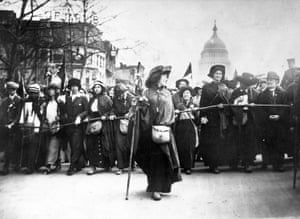Suffrage review: epic retelling of US women’s long battle for the vote

It was a decidedly anticlimactic end to a life-changing campaign. The document was sent by train to Washington in the middle of the night. A government employee met the train and rushed it to the secretary of state, Bainbridge Colby, who signed the Proclamation of Ratification at dawn, three days after Tennessee became the 36th state to vote for women’s suffrage.
In this centennial year, it seems a miracle the 19th amendment ever became law. The “longest revolution” began in earnest at Seneca Falls, New York, in 1848. It survived the civil war and the first world war and dozens of failed state votes. Suffragists were jailed, their protests mobbed, their arguments mocked in the press, on the floor of the House and Senate and in every state legislature. Decade after decade, suffrage remained a hopeless cause that consumed the lives of brave, persistent and often brilliant women.
Ellen Carol DuBois has written a comprehensive history that deftly tackles intricate political complexities and conflicts and still somehow reads with nail-biting suspense.
With the current feminist movement now in its fourth wave, how many American suffragettes are household names, besides perhaps Susan B Anthony and Elizabeth Cady Stanton? Thanks to DuBois, a UCLA professor and noted suffrage scholar, many more now spring to life. Her colorful cast includes the more prominent leaders – Anthony, Stanton, Sojourner Truth, Ida B Wells, Carrie Chapman Catt, Victoria Woodhull, Alice Paul – but DuBois gives supporting roles to many members of the “petticoat brigade” heretofore largely lost to history.
Sisters Sarah J Garnet and Susan Smith-McKinney founded the Brooklyn Equal Suffrage League, the first such black women’s organization. Mary Kenny O’Sullivan and Clara Lemlich rallied working-class women. Kentucky had Madeline Breckinridge, California had Laura de Force Gordon and Clara Foltz, New Mexico had Adelina Otero-Warren.
Inez Milholland Boissevain, a pioneering war correspondent, traveled to 12 western states only to drop dead, exhausted, on 25 November 1916. She was 30. All of these women and many more deserve statues in capitol buildings.
Women’s suffrage grew out of the abolitionist movement but abolitionists jettisoned universal suffrage with the 14th and 15th amendments, which protected the vote only for male former slaves. Furious, Stanton, a close friend of Frederick Douglass, made the tragic decision to begin using anti-black and anti-immigrant rhetoric. One of her refrains: “Think of Patrick and Sambo and Hans and Yung Tung … making the laws” for educated white women. Over the next 50 years, the suffrage movement would tangle with a racist “southern strategy” as it tried to pass referendums state by state.
As the alliance between male abolitionists and female suffragists fractured, Frances Ellen Watkins Harper, a black abolitionist and suffragist, tried to mediate, eventually confessing in 1869 that “when it was a question of race, she let the lesser questions of sex go”. One hundred years later, the same “lesser question of sex” would put black women in a similar bind of loyalty between civil rights and the second-wave feminist movement. A split similar to that between mainstream suffragists (Anthony and Catt) and radicals (Woodhull and Paul) would visit the second-wave feminists, decades later.
DuBois reveals the root of the refusal to give women the vote: deep-seated misogyny whose grip on public mores surpassed even vicious racism. DuBois reminds us of this fundamental truth throughout her book. Each time it comes as a shock.
The day before Woodrow Wilson’s inauguration in March 1913, Alice Paul planned an audacious and unprecedented parade from the Capitol, past the White House to the US Treasury. Inez Milholland led the demonstration astride her horse, followed by a flower-covered cart carrying a banner with the message: “Amendment to the Constitution of the United States Enfranchising the Women of the Country.”
Women converged by the thousands (including black delegations from Illinois and Howard University) and marched in ladylike fashion. A mob of men broke through deliberately passive police lines and seized the women, wrenching at their clothes and signs and harassing them “with all manner of smutty conversation”. The army had to be called in.
Paul took notes from the militant British suffragette Emmeline Pankhurst (British women – some of them – gained the vote in February 1918) and started a White House picketing campaign in 1917 – the very first time activists had done so.
Women taunted Wilson with signs such as: “MR PRESIDENT WHAT WILL YOU DO FOR WOMAN SUFFRAGE?” Picketers were attacked, arrested and imprisoned. Dozens, including Paul, were tortured and force-fed. Suffragist defiance forced Wilson and Congress to relent.
Which brings us the real reason that the triumph of 26 August 1920 was anticlimactic. By 1970, second-wave feminists had barely begun to find traction in seeking equal financial, legal, medical and personal rights – none of which had significantly improved since 1920. As radical feminist Shulamith Firestone wrote in The Dialectic of Sex: “By the time the vote was granted, the long channeling of feminist energies into the limited goal of suffrage – seen initially as only one step to political power – had thoroughly depleted the Women’s Rights Movement. The monster Ballot had swallowed everything else.”
In her fascinating depiction of suffrage’s epic journey, DuBois proves Firestone right.
